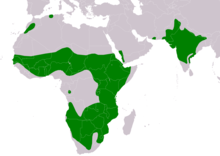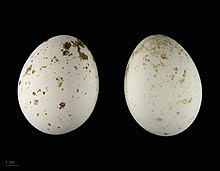Predatory eagle
| Predatory eagle | ||||||||||||
|---|---|---|---|---|---|---|---|---|---|---|---|---|

Predatory eagle ( A. r. Rapax ) |
||||||||||||
| Systematics | ||||||||||||
|
||||||||||||
| Scientific name | ||||||||||||
| Aquila rapax | ||||||||||||
| ( Temminck , 1828) |
The predatory eagle or savanna eagle ( Aquila rapax ) is a species of bird from the hawk-like family (Accipitridae). This medium-sized representative of the subfamily Aquilinae colonizes large parts of Africa south of the Sahara and the Indian subcontinent. The species is also found in small areas in northern Africa, on the Arabian Peninsula and possibly in Myanmar . The species predominantly inhabits dry landscapes with loose trees; The spectrum of populated habitats ranges from wooded savannahs, dry forests and thorn bush forests to semi-deserts. The predatory eagle feeds on small to medium-sized vertebrates, insects and also regularly on carrion. It often parasitizes other birds of prey, storks or ground hornbills .
Predatory eagles are predominantly resident birds , but at least in Africa the species lives partially nomadic and from there seasonal migrations over short distances are known. The species is common in large parts of the distribution area and is very adaptable, the world population is therefore considered to be harmless.
description
Predatory eagles belong to the medium-sized representatives of the genus Aquila . They reach a body length of 60 to 72 cm and a wingspan of 1.59 to 1.83 m and are therefore considerably larger than a common buzzard . The sexual dimorphism is relatively small in terms of size and weight, males reach an average of about 89% of the size of the females. Males of the nominate form weigh 1.6 to 2.0 kg and have a wing length of 485 to 540 mm, females reach a weight of 1.6 to 2.4 kg and a wing length of 509 to 565 mm. As with all representatives of the Aquila genus , the tips of the hand wings are heavily fingered and the legs are feathered down to the toes. In flight, the wings appear relatively long and wide, the hand wing is somewhat narrowed. The leg fletching is very pronounced and often puffy. The medium-long, broad tail is slightly rounded at the end. The corner of the beak extends backwards to below the center of the eye.
The color of adult birds is variable. Head, trunk, small and medium-sized upper and lower wing coverts can be monochrome light yellow-brown, red-brown, medium-brown or dark-brown. In medium-light birds, the upper wing-coverts in particular have light centers, in light birds, on the other hand, they often have dark centers, so that the upper side is mottled with light or darkly. The large hand and arm covers are dark gray-brown in all morphs . The flight feathers and the control feathers are dark gray-brown with a fine dark transverse banding, the distal halves of the outer hand wings are black.
In birds of the nominate form , the iris is light yellow, yellow-brown or pale brown, the wax skin and the toes are yellow in color. The beak is gray at the base and black towards the tip.
In juvenile plumage , the head, trunk and small and medium-sized upper and lower wing coverts are usually monochrome, light reddish brown or yellow-brown, rarely medium brown. The lower back and upper tail-coverts are whitish cream-colored. The large upper wing coverts are dark gray with a white end band and thus form a narrow, light band on the upper wing. The large under wing-coverts are bordered dark gray and whitish. The wings and shock springs are almost unbanded and mostly monochrome dark gray, the inner hand wings , the arm wings and the control springs are also edged in white. The iris is dark brown. The age at which the birds are colored is not yet known.
The very similar steppe eagle differs from the adult predatory eagle by the more monochrome and mostly medium or dark brown plumage, a dark rear edge on the wings and tail, a dark iris and the corner of the beak that extends to the rear edge of the eye. In comparison to juvenile predatory eagles, steppe eagles in youthful dress show a very noticeable light band on the underside of their wings, which is formed by the large hand and arm covers.
Vocalizations
The most common utterance in the breeding area is a harsh, barking, mostly two-syllable call, which is circumscribed as " kauk-kauk " or " kau-kau " and which can be heard both while flying and sitting and from both sexes. When chasing birds of prey and other bird species with prey, predatory eagles harshly call out " kra ".
distribution and habitat
The ( disjoint ) distribution area of the species, which comprises several spatially isolated sub-areas, includes Africa and a small part of the Arabian Peninsula on the one hand, and central southern Asia on the other. In Africa, the species occurs in a relatively closed area that extends from the southern edge of the Sahara, excluding the central and west African rainforest, to central South Africa. Spatially isolated from it, the species also breeds in North Africa in central Morocco ; It is uncertain whether there are still breeding occurrences in northern Algeria . On the Arabian Peninsula, the species only breeds in a small area in western Yemen and then to the north in the most south-westerly Saudi Arabia . In Asia, the distribution area covers the southeast of Iran and further east large parts of the Indian subcontinent from East Pakistan to the Indian state of Assam . The species may also occur sporadically as a breeding bird in central Myanmar .
The predatory eagle predominantly inhabits dry landscapes with a loose tree population; The spectrum of populated habitats ranges from wooded savannahs, dry forests and thorn bush forests to semi-deserts. In contrast to this, the species inhabits forests in Morocco or near mountains with bordering open plains and in West Africa it inhabits moist forest savannahs during the breeding season, but migrates further north in dry forests and semi-deserts outside of the breeding season. Areas used for agriculture are also settled; In India in particular, the predatory eagle is often found near villages. The species occurs up to an altitude of 3000 m, but mostly flatlands are inhabited.
Systematics
For a long time, the predatory eagle was grouped into one species with the very similar steppe eagle . Molecular genetic studies have confirmed the species status of both taxa. According to these investigations, the closest relative of the predatory eagle is not the steppe eagle, but the eastern imperial eagle ( Aquila heliaca ).
Three subspecies are currently recognized, but they hardly differ from one another:
- A. r. rapax ; southern Africa, north to south of the Democratic Republic of the Congo and to central Kenya .
- A. r. belisarius ; North and West Africa and the Arabian Peninsula ; slightly larger, usually a bit more elegant, less contrasting and more brown and less red-tinged in color.
- A. r. vindhiana ; southern Asia; Small, adult birds without red tones, pale morphs of gray, juvenile and immature birds more reddish and resembling adult birds of the nominate form, irises are often brown in adult birds too.
Way of hunting and food
The predatory eagle feeds on small to medium-sized vertebrates, insects and also regularly on carrion. Animals are almost exclusively captured on the ground. The predatory eagle essentially uses three methods to hunt ground-dwelling animals: high-seat hunting, hitting the ground from a circling search flight and hunting on foot. Other prey-bearing birds of prey, storks or ground hornbills are also attacked from higher circles or gliding in order to steal their prey - when such birds are very agile in pursuit, they are often called.
Most of the captured vertebrates weigh between 0.125 and 2.0 kg, for example the diet in Kenya consisted mainly of kaphases , kirk dikdiks , yellow-throated francolines ( Francolinus leucoscepus ) and red- capped bustards ( Lophotis ruficrista ). Carrion is regularly used in every possible form, as hunted prey, slaughterhouse waste, road victims or together with vultures in the form of large dead animals. Common insects like termites are mainly eaten outside of the breeding season.
Reproduction
The courtship usually consists of the high circles of one or both couple partners above the breeding site, with intensive calls. Occasionally the partners playfully fly mock attacks on each other. Wave flights with simultaneous calling have been documented for males, but these courtship elements seem to be rare.
The breeding season of the predatory eagle is very different in the large distribution area depending on the geographical location of the occurrence, in large parts of the area it falls during the respective dry season. It falls in North and Northeast Africa from March to August, in West Africa from October to June, in Kenya from May to November, in Central and South Africa from April to January and in South Asia from November to August.
The large nests are mainly erected on trees, mostly on acacias , only rarely on masts. Most of the time the trees used are more or less free, but there is often a water point nearby. The nests are mostly exposed on the treetop at heights of up to 30 m and consist of branches, occasionally animal bones are also built in. New nests have a diameter of 1.0 to 1.3 m and are about 30 cm high; they get bigger with repeated use. The nest hollow is laid out with grass, leaves and scraps of fur.
The clutch consists of one to three, usually two eggs. The breeding season is about 39–45 days, the nestling period lasts 76 to 85 days. The young birds are independent after about six weeks, but sometimes stay in their parents' territory until the next breeding season.
hikes
Predatory eagles are predominantly resident birds, but at least in Africa the species lives partially nomadic and from there seasonal migrations over short distances are known. The predatory eagles of West Africa migrate further north to the dry forests and semi-deserts in April, only to return to the breeding area, the moist forest savannah, in October and November. Individual predatory eagles have been identified as random visitors in Tunisia , Israel , Egypt and Oman .
Existence and endangerment
There is no reliable information on the world population , the IUCN gives a very rough estimate of 100,000–1,000,000 individuals. Despite regional population declines, the IUCN classifies the species as a whole as ![]() (= least concern - not endangered).
(= least concern - not endangered).
swell
Individual evidence
- ^ J. Ferguson-Lees, DA Christie: Raptors of the World. Christopher Helm, London, 2001. ISBN 0-7136-8026-1 : p. 733
- ↑ HRL Lerner, DP Mindell: Phylogeny of eagles, Old World vultures and other Accipitridae based on nuclear and mitochondrial DNA . Molecular Phylogenetics and Evolution 37; 2005: pp. 327-346.
- ↑ M. Wink, H. Sauer-Gürth: Phylogenetic Relationships in Diurnal Raptors based on nucleotide sequences of mitochondrial and nuclear marker genes . In: RD Chancellor, B.-U. Meyburg (Ed.): Raptors Worldwide . Berlin, Budapest, 2004: pp. 483–498.
- ^ J. Ferguson-Lees, DA Christie: Raptors of the World. Christopher Helm, London, 2001. ISBN 0-7136-8026-1 : pp. 732-733
literature
- J. Ferguson-Lees, DA Christie: Raptors of the World. Christopher Helm, London 2001, ISBN 0-7136-8026-1 , pp. 238-239 and 730-733.
- L. Svensson, PJ Grant, K. Mullarney, D. Zetterström: The new cosmos bird guide . Kosmos, Stuttgart 1999, ISBN 3-440-07720-9 , pp. 80-81.
Web links
- Aquila rapax in the Red List of Threatened Species of the IUCN 2008. Posted by: BirdLife International, 2008. Accessed on December 12 of 2008.
- Videos, photos and sound recordings of Aquila rapax in the Internet Bird Collection
- Recordings from the great outdoors at www.fokus-natur.de




